Wireless Connectivity Market Size
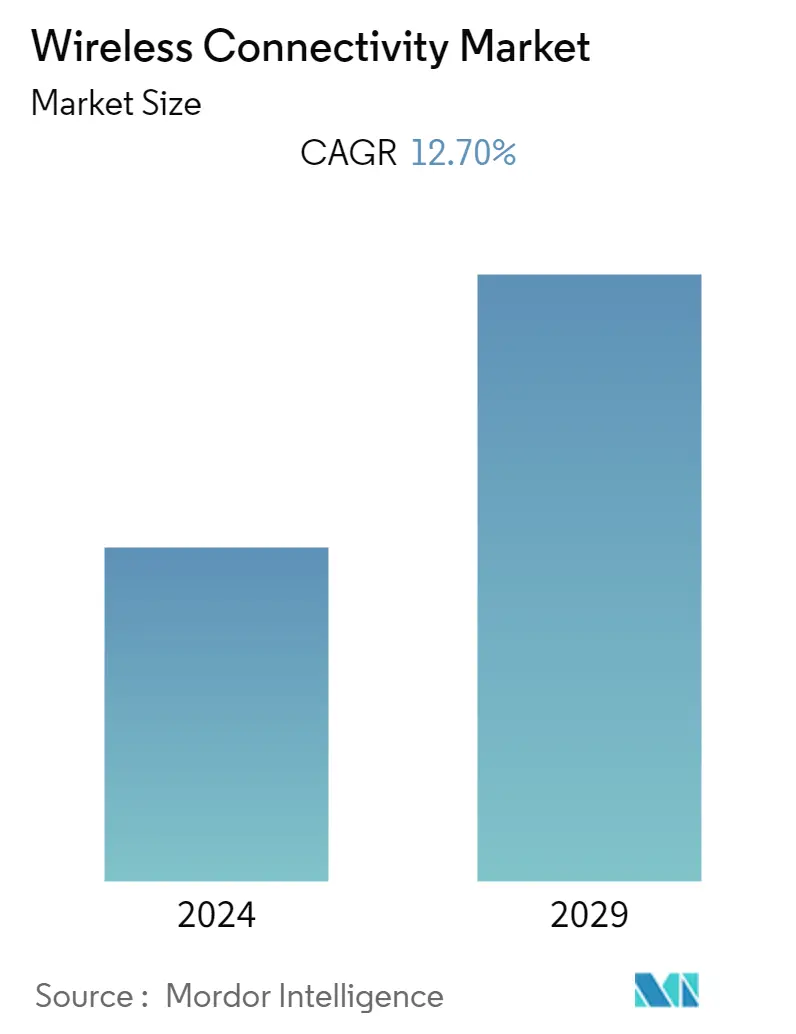
| Study Period | 2019 - 2029 |
| Base Year For Estimation | 2023 |
| CAGR | 12.70 % |
| Fastest Growing Market | Asia-Pacific |
| Largest Market | North America |
| Market Concentration | High |
Major Players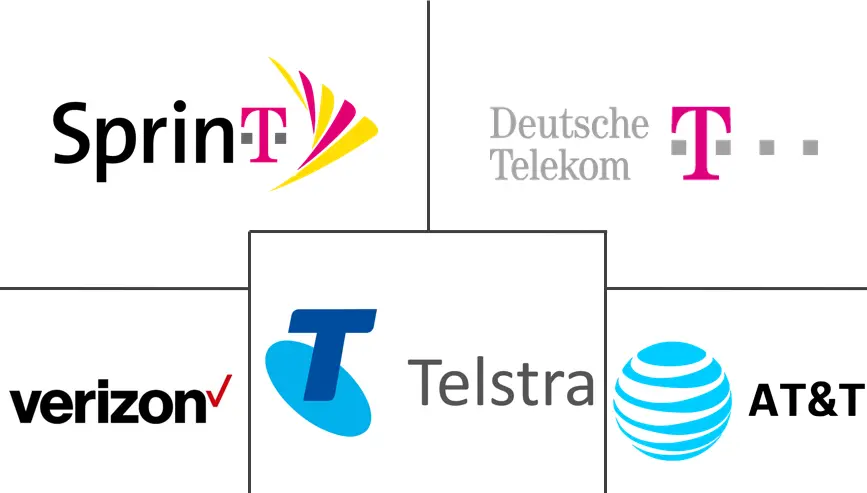
*Disclaimer: Major Players sorted in no particular order |
Need a report that reflects how COVID-19 has impacted this market and its growth?
Wireless Connectivity Market Analysis
The wireless connectivity market is expected to register a CAGR of 12.7% during the forecast period. The proliferation of the market is to be driven by the growing demand for consumer electronic devices. Further, the adoption of advanced technologies like AI, IoT, AR, and VR is also expected to remain high in many end-user industry verticals. The creation of smart infrastructure worldwide is also a significant factor driving the demand for wireless sensor networks.
- End-user industries like the oil and gas industry extensively use reliable, secure, and resilient networks to offer seamless communications for day-to-day operations. With its service-oriented virtual private network (VPN), Multiprotocol Label Switching (MPLS) has been meeting many of these industry needs by bringing together many applications.
- Working from home has become a megatrend these days. The speed of the shift to large-scale remote work has resulted in the use of personal devices, including mobile phones, laptops, tablets, desktops, etc. Employees are also observed using personal Wi-Fi internet connections to access the corporate network.
- The increasing use of data analytics in critical industries, like healthcare, is expected to further drive wireless connectivity for further real-time information gathering. According to Philips, 92 percent of the healthcare organizations in Singapore adopted predictive analytics, followed by China, with 79 percent, Brazil, and the United States, with a 66 percent adoption rate in the last year.
- The development of smart infrastructure is expected to act as a significant driver for the market. Moreover, intelligence and connectivity enable the digital transformation of critical energy, water, and city services. For instance, in June last year, Siemens Smart Infrastructure launched Building X, a new smart building suite that is open, interoperable, and completely cloud-based. The suite is the first next-generation solution built on the design principles of Siemens Xcelerator, an open digital business platform made to drive digital transformation and value creation in transportation, grids, and buildings.
- Since COVID-19 became a catalyst for work-from-home, the demand for high-performance Wi-Fi increased. Various consumers upgraded their home Wi-Fi in 2021 and purchased additional Wi-Fi devices last year due to Wi-Fi 6's simplified wireless transmissions and enhanced uploads. Wireless networks are gearing up to connect large numbers of devices in one location without a loss in performance, giving rise to Wi-Fi 7. Such consistent growth in wireless connectivity is expected to boost market growth.
Wireless Connectivity Market Trends
This section covers the major market trends shaping the Wireless Connectivity Market according to our research experts:
Deployment in Automotive Industry is Expected to Drive Market Growth
- By using wireless connectivity like Wi-Fi and Bluetooth, users are able to connect their smartphones and other smart devices to their infotainment systems. Users can pair their devices with infotainment systems. It can respond to voice commands, handle hands-free mode to answer calls while driving, and operate systems easily and conveniently.
- Moreover, with the help of wireless connectivity, users can locate their vehicles precisely and transmit information with considerably low latency. Smart cars can communicate with modern communication networks like LTE and LTE Advanced. A supercharged 5G network and the Internet of Things will effectively manage smart driving.
- Autonomous and connected vehicles are gaining popularity among consumers and are expected to achieve wider acceptance over the predicted period. The advanced driving assistance systems (ADAS) on display are intended to close the gap between today's cars and those of tomorrow. Furthermore, with increased technological breakthroughs in the automobile industry, end customers are willing to pay more for the latest technology that improves the driving experience and promotes driver and passenger safety.
- Moreover, in March last year, GM Middle East launched new in-vehicle technology with Google built-in, strengthening connectivity leadership and enhancing the customer experience. General Motors Middle East has announced the introduction of infotainment systems with Google built in, as part of its vehicle intelligence technology goals. These new features would augment the overall customer experience and make it easier for customers to bring their digital lives into future connected vehicles. The Google built-in services would be standard on LT and higher trims, with widespread deployment across all GM vehicle brands equipped with the OnStar module system. Thus, customers in Kuwait and the UAE can utilize Google built-in via their Wi-Fi plans, while those in KSA and Bahrain can connect through their personal mobile Wi-Fi hotspots.
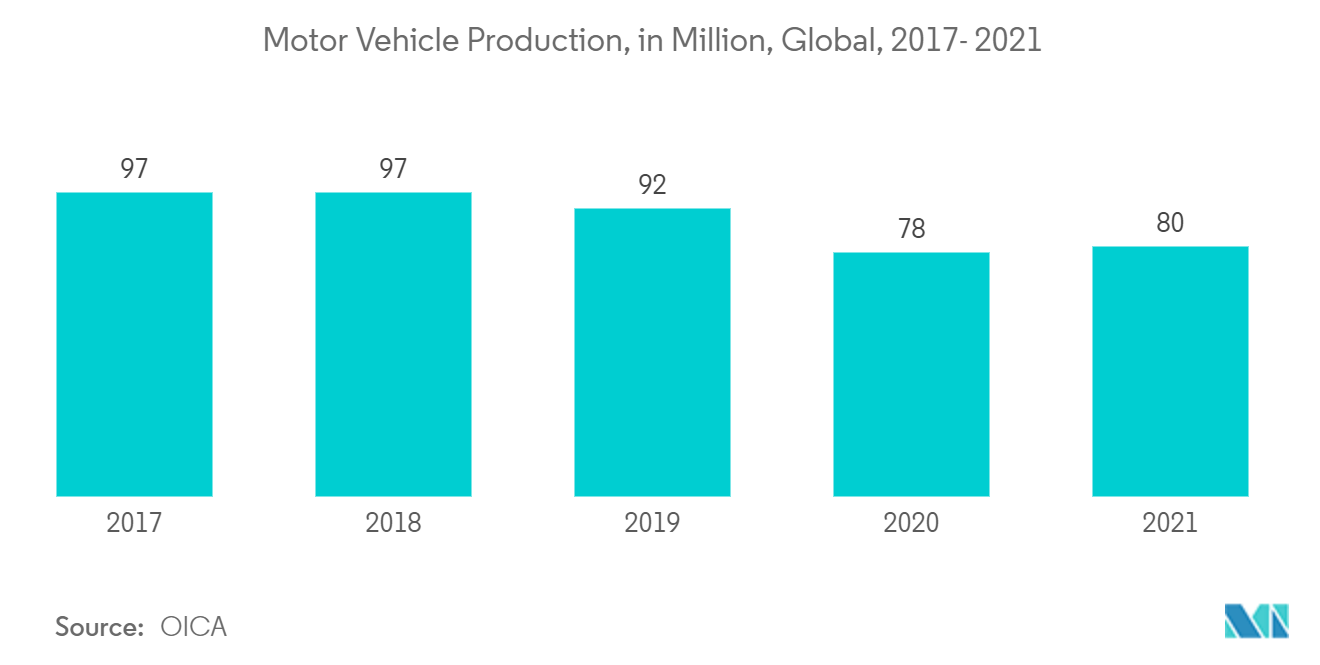
Asia-Pacific is Expected to be the Fastest Growing Market in the World
- Asia-Pacific has been an early adopter of technological advancements such as AL and IoT. In these developing economies, the market poses a key advantage in implementing industrial automation since it is not tormented with rebuilding legacy automation systems and machine investments.
- The Asia-Pacific market is predicted to witness the highest growth for wireless connectivity systems. For instance, according to the U.S.-China Economic and Security Review Commission, government spending on smart city initiatives in China would reach USD 38.92 billion in the current year. The development of smart infrastructure is expected to open new avenues for wireless connectivity systems.
- The rise in the trend towards smart cities is pushing firms or institutions to develop new products or solutions to ease the development of smart cities in the region. For instance, in October last year, the IIIT Hyderabad Smart City Living Lab, in collaboration with Silicon Labs, a leader in secure, intelligent wireless technology, announced the introduction of a campus-wide Wi-SUN network to support research and solutions for the Internet of Things (IoT) and smart cities. Such developments are accelerating the demand for wireless connectivity across the region.
- Additionally, the expansion of 5G networks in the region is expected to be one of the major factors driving the market's growth, both directly and indirectly. According to the GSMA's latest report, 5G is expected to contribute about USD 960 billion to the developed economies of East Asia and the Pacific by 2030. 5G is expected to be a significant driving force in automated smart factory deployments in the region.
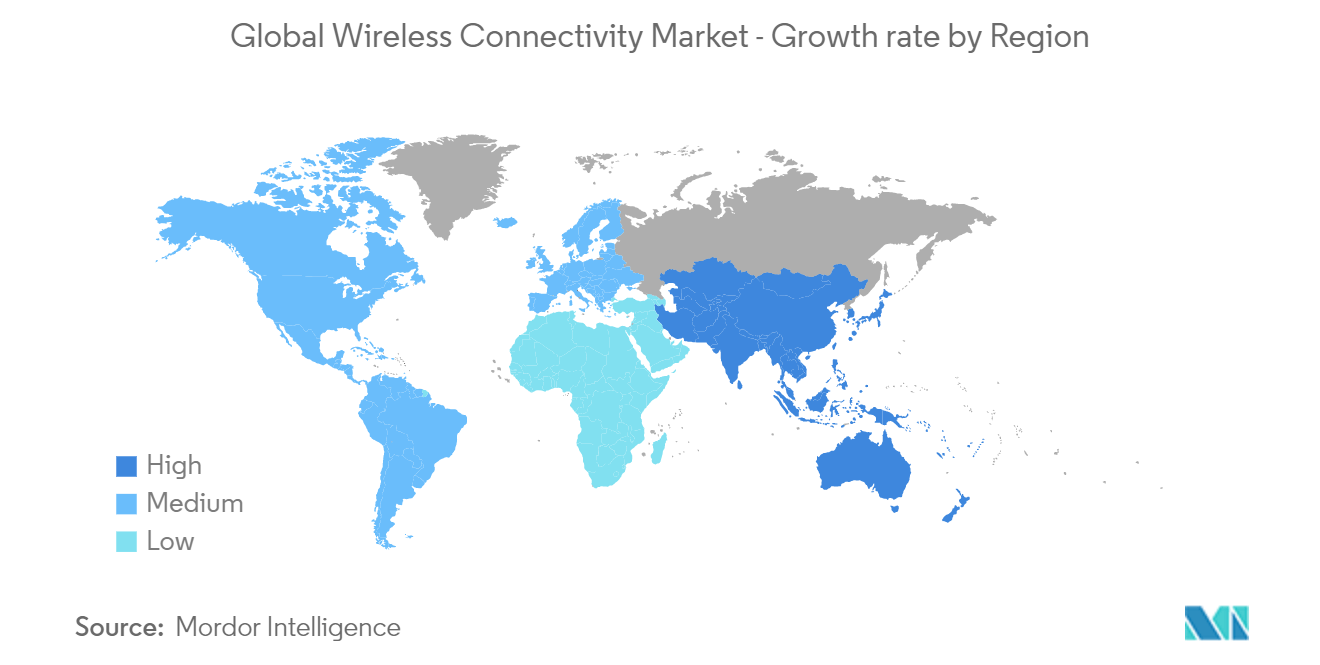
Wireless Connectivity Industry Overview
The competitive landscape for the wireless connectivity market is consolidated, with the major market share dominated by a few players such as AT & T, Verizon Communications Inc., Sprint (T-Mobile, Inc.), and Deutsche Telekom AG. With evolving technologies and end-user requirements driving innovation, the market remains extremely dynamic.The following are some recent market developments:
In August 2022, AT&T announced that it was expanding its Fiber Internet Service to Arizona, and it is expected to be available to local residents in 2023. The company expects to offer speeds of up to 5 gigabits per second of fiber-based broadband to more than 100,000 homes in and around Mesa.
In February 2022, Verizon announced the expansion of its Internet service by providing the ability to access reliable, fast plug-and-play wireless Internet services around the country, covering over 30 million homes and more than 2 million businesses.
Wireless Connectivity Market Leaders
AT & T
Verizon Communications Inc
Sprint (T-Mobile, Inc.)
Deutsche Telekom AG
Telstra Corporation Limited
*Disclaimer: Major Players sorted in no particular order
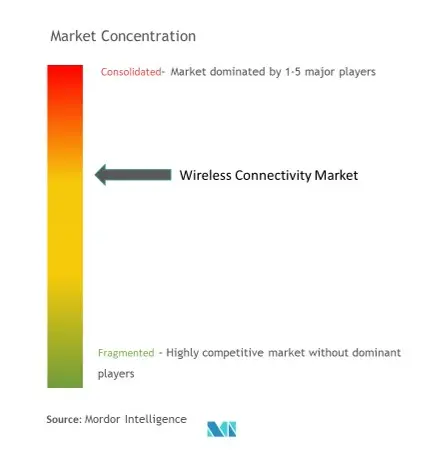
Wireless Connectivity Market News
- November 2022: A provider of cellular vehicle-to-everything (C-V2X) and automotive solutions, Quectel Wireless Solutions, has announced the release of its new AG18 module. The module's PC5 direct communications feature allows for efficient communication between cars and their surroundings, enhancing traffic efficiency and safety.
- January 2022: Telstra announced the deployment of Ericsson Private 5G, an on-premise dedicated 5G network for enterprises that utilizes a single-server 5G dual-mode core. Telstra's advanced network capabilities offer an industrial wireless connectivity platform for the enterprise that can deliver low latency and enhanced resiliency.
Wireless Connectivity Market Report - Table of Contents
1. INTRODUCTION
1.1 Study Assumptions and Market Definition
1.2 Scope of the Study
2. RESEARCH METHODOLOGY
3. EXECUTIVE SUMMARY
4. MARKET INSIGHTS
4.1 Market Overview
4.2 Industry Value Chain Analysis
4.3 Industry Attractiveness - Porter's Five Forces Analysis
4.3.1 Bargaining Power of Suppliers
4.3.2 Bargaining Power of Consumers
4.3.3 Threat of New Entrants
4.3.4 Threat of Substitutes
4.3.5 Intensity of Competitive Rivalry
4.4 Assessment of Impact of Covid-19 on the Market
5. MARKET DYNAMICS
5.1 Market Drivers
5.1.1 Proliferation of IoT and Connected Devices is Expected to Drive Demand for Robust Wireless Connectivity Solutions
5.1.2 Increased Demand for Wireless Sensor Networks to Create Smart Infrastructure
5.2 Market Challenges
5.2.1 Data Privacy and Security Concerns will Act as a Restraint for Market Growth
5.2.2 Lack of Infrastructure, Huge Implementation Cost, and Absence of Technology Know-how in Third World Countries
6. MARKET SEGMENTATION
6.1 By Technology
6.1.1 Wi-Fi
6.1.2 Bluetooth
6.1.3 Zigbee
6.1.4 Other Technologies
6.2 By End-user Industry
6.2.1 Automotive
6.2.2 Industrial
6.2.3 Healthcare
6.2.4 Energy
6.2.5 Infrastructure
6.2.6 Other End-user Industries
6.3 By Geography
6.3.1 North America
6.3.2 Europe
6.3.3 Asia-Pacific
6.3.4 Rest of the World
7. COMPETITIVE LANDSCAPE COMPANY PROFILES*
7.1 AT&T Inc.
7.2 Verizon Communications Inc.
7.3 Sprint (T-Mobile, Inc.)
7.4 Deutsche Telekom AG
7.5 Telstra Corporation Limited
7.6 Vodafone Group
7.7 CenturyLink (Lumen)
7.8 NTT Communications
8. INVESTMENT ANALYSIS
9. FUTURE OF THE MARKET
Wireless Connectivity Industry Segmentation
The wireless network comprises a computer network that utilizes wireless data connections between network nodes. Various end-user segments use wireless connectivity to address critical connectivity issues and augment daily operational requirements.
The wireless connectivity market is segmented by technology (Wi-Fi, Bluetooth, Zigbee, and other technologies), end-user industry (automotive, industrial, healthcare, energy, infrastructure, and other end-user industries), and geography (North America, Europe, and Asia-Pacific).
The market sizes and forecasts are provided in terms of value (USD million) for all the above segments.
| By Technology | |
| Wi-Fi | |
| Bluetooth | |
| Zigbee | |
| Other Technologies |
| By End-user Industry | |
| Automotive | |
| Industrial | |
| Healthcare | |
| Energy | |
| Infrastructure | |
| Other End-user Industries |
| By Geography | |
| North America | |
| Europe | |
| Asia-Pacific | |
| Rest of the World |
Wireless Connectivity Market Research FAQs
What is the current Wireless Connectivity Market size?
The Wireless Connectivity Market is projected to register a CAGR of 12.70% during the forecast period (2024-2029)
Who are the key players in Wireless Connectivity Market?
AT & T, Verizon Communications Inc, Sprint (T-Mobile, Inc.), Deutsche Telekom AG and Telstra Corporation Limited are the major companies operating in the Wireless Connectivity Market.
Which is the fastest growing region in Wireless Connectivity Market?
Asia-Pacific is estimated to grow at the highest CAGR over the forecast period (2024-2029).
Which region has the biggest share in Wireless Connectivity Market?
In 2024, the North America accounts for the largest market share in Wireless Connectivity Market.
What years does this Wireless Connectivity Market cover?
The report covers the Wireless Connectivity Market historical market size for years: 2019, 2020, 2021, 2022 and 2023. The report also forecasts the Wireless Connectivity Market size for years: 2024, 2025, 2026, 2027, 2028 and 2029.
Wireless Connectivity Industry Report
Statistics for the 2023 Wireless Connectivity market share, size and revenue growth rate, created by Mordor Intelligence™ Industry Reports. Wireless Connectivity analysis includes a market forecast outlook to 2029 and historical overview. Get a sample of this industry analysis as a free report PDF download.
